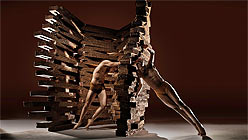“What’s brought into our lives, bitter or sweet, is designed for us, and we’re meant to learn from it, and that’s what all my ballets are about,” says King. “There’s an endemic in the world. What is that endemic? That most people think they are weak, whining mortals. And that’s one of the great things about art — to slap you and wake you up and say, ‘No you’re not. You have divinity in you. And you have no limitation.’ That is the point of art — to tap into what can’t be seen, tasted or smelled; any of the senses except intuition. Because most people know in the quiet moments that, ‘There’s something great in me. Something I have to realize.’ They’re misguided when they think, ‘I should go for fame.’ No. What they have to realize is who they are. That would be an astonishing revelation. And it takes lifetimes to achieve.”
Though he holds “fame” at a distance, King has achieved high recognition throughout the art and dance worlds, receiving a Jacob’s Pillow Creativity Award (given annually to “an artist of exceptional vision”), a United States Artists award (a $50,000 fellowship), and a National Endowment for the Arts Choreographer’s Fellowship. King’s ballet company, which he founded in 1982, frequently tours abroad, as it will do next month in France. Last November, a daily paper in Italy called King’s dancers “impeccable” with “bodies like sculptures.” That’s an apt description, though King would add another important qualification: “They’re collaborators,” he says, meaning the dancers bring their own insight into King’s orchestrations. And what the dancers experience on stage, and in the rehearsal room that King oversees, is designed to stir them up. To achieve that, King has worked many times with well-known musicians, saxophonist Pharoah Sanders and tabla player Zakir Hussain among them.
“Dance is thought made visible,” King says. “Music is thought made audible. And we are placing them together to create a thought structure for people to contemplate, to drink in, to step in.”
Haas’s architecture relates to the pre-birth lives we all experience, and is a reminder that architecture and dance are intricately related, King says. “In architecture, the first world we inhabit is these bodies,” King offers, looking at his own. “That’s our first architecture. And when the baby is developing in the amniotic fluid of the mother, what is that? It’s ‘home.’ So after that, everything that we have is a recreation of home, because these houses that we build to inhabit are safe places for transition and experience and for learning to become who you are . . . So often you hear people say, ‘Well, architecture and dance are really different,’ or ‘engineering and dance are really different’ or ‘agriculture and dance are really different.’ That’s such crap. All making and doing that human beings do is based on the same principle. And all of them — even though they may use different tools — have the same end. And when they’re taken to their finest, whether that’s basketball, or classical ballet, they all become a poetry. That’s the point. At their highest level, they become a poetry.”
The Alonzo King LINES Ballet, as King’s dance company is officially called, continues its collaboration with Haas and Hart through April 24, 2011 at Yerba Buena Center for the Arts. The eight days of performances are the company’s “Spring Home Season,” which segues into its three-week tour of France. In their San Francisco rehearsal space, the dancers have practiced everything from maneuvering their way through the elastic strings to collapsing on the ground with a sudden thud. With each move, King watches and waits. He wants to be surprised in a good way. And when he is, as he was when I saw him, this is what he says to his dancers: “Good. Great. Beautiful.” The words come out without hesitation. They’re how he feels in the moment. For Alonzo King, feeling a performance is everything.
“So often people ask me, ‘How should I come (to see your dance company)?'” King says. “I say, ‘Always come with receptivity.’ People cut off their feelings, and they say (about the performances), ‘Well, what does it mean?’ And that’s a legitimate question. And it should be addressed. But I say, ‘Well, why don’t you feel it?’ You have the answer.”
The Alonzo King LINES Ballet performs April 15-24, 2011 at Yerba Buena Center for the Arts. For tickets and information visit linesballet.org.



